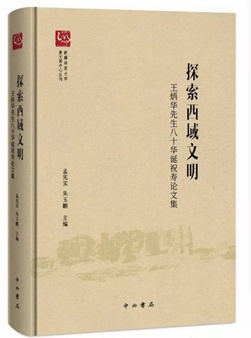
. > WHAT'S NEW > BOOKS
Seeking traces of Xinjiang archaeology
Author : LIU ZIFAN Source : Chinese Social Sciences Today 2018-05-08

Exploring Civilization of the Western Region
Editor-in-chief: Meng Xianshi and Zhu Yuqi
Publisher: Zhongxi Publishing House
Xinjiang is known as the crossroads of ancient civilizations. It is not only the place where the East and West meet, but where the nomadic and oasis cultures encounter each other. The activities of early Western explorers were mostly concentrated in the Tarim Basin and its surrounding areas, while archaeology in northern Xinjiang was almost blank. Archaeologist Wang Binghua’s earliest work was to unfold the nomadic cultural relics to the north of the Tianshan Mountains, opening up a new chapter for Xinjiang’s archeology.
From 1962 to 1963, Wang, Yi Manbai and Wang Mingzhe excavated a large mound tomb in Xitai, Zhaosu County. This excavation was undoubtedly a milestone and officially set the stage for archaeological excavations in the Ili River Basin. In the same year, Wang collected 11 bronzewares from the Tekes County and pointed out that the previous perception that “nomadic areas lack historical and cultural relics” was mistaken. These works have largely established the basic understanding of archaeology in the Ili River Basin.
In 1987, by chance, Wang discovered the Kangjia Shimenzi rock paintings in the hinterland of the Tianshan Mountains. With a total area of 120 square meters, the rock painting was a spectacular artwork with approximately 300 characters on it. Among them, many male genitals are prominently portrayed, even with scenes of copulation. Wang believes that the rock painting revealed ancient people’s worship of reproduction. Since then, Wang has also conducted research on worship for reproduction and the number “seven” as it is reflected in the paintings of the Aletai Mountain Caverns and in the Xiaohe Cemetery. From this we can see that the spiritual world of these ancient people was also an important aspect of Wang’s academic research.
The re-discovery of Loulan is undoubtedly one of the most important achievements in the history of Xinjiang archaeology. After visits to Loulan by Sven Hedin and Aurel Stein in the early 20th century, Loulan’s archaeology was once silenced. It was not until 1979 that Wang led his team to the Peacock River Valley, northwest of Lop Nor, to investigate and discover the ancient tomb ditch.
In addition to the remarkable “Sun tomb,” another important discovery was the excavation of a woman’s body with golden hair. Subsequent anatomical analysis showed that the skull has obvious European characteristics.
The Niya Site is located in the desert north of Minfeng County and was home to the Jingjue kingdom during the Han Dynasty. As the director of the Institute of Archeology, Wang has been directing the academic work related to China-Japan cooperation on the Niya site since 1991. During their work, the exquisite cultural relics of M3 caused a huge sensation.
The expansion of the Silk Road links the Central Plains and the Western Regions closely. Wang used archaeological data to show the influence and development of Han culture in the Western Regions. He studied on unearthed cultural relics in the area of Alagou and pointed out that the silk fabrics from the Central Plains had spread widely to the regions farther away than ancient Xinjiang in the Spring, Autumn and Warring States period.
(Edited and translated by SUI JINGJING)
Ye Shengtao made Chinese fairy tales from a wilderness
Ye Shengtao (1894–1988) created the first collection of fairy tales in the history of Chinese children’s literature...
-
How northern ethnicities integrated into Chinese nation
2023-09-18
-
Mogao caves
2023-09-12
-
Mogao Grottoes as ‘a place of pilgrimage’
2023-09-12
-
Time-honored architectural traditions in China
2023-08-29
-
Disentangling the civilizational evolution of China
2023-08-28
-
AI ethics in science fiction
2023-08-23













 2011-2013 by www.cssn.cn. All Rights Reserved
2011-2013 by www.cssn.cn. All Rights Reserved